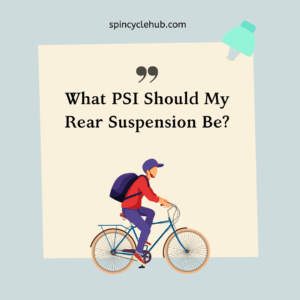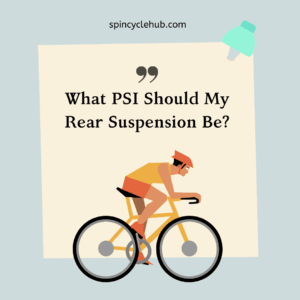Introduction
When it comes to fine-tuning your bike’s performance and comfort, finding the right PSI (pounds per square inch) for your rear suspension is crucial. A properly adjusted rear suspension can enhance your riding experience, whether you’re a casual rider hitting the trails on the weekends or a hardcore mountain biker pushing your limits. In this article, we’ll explore the factors to consider and provide practical tips to help you determine the ideal PSI for your rear suspension.
Understanding Rear Suspension PSI
The PSI refers to the air pressure within your rear suspension. It plays a vital role in how your suspension absorbs impacts, maintains traction, and provides a balanced ride. The right PSI allows your rear suspension to effectively handle rough terrain while keeping your bike stable and responsive.

Factors to Consider
Several factors influence the optimal PSI for your rear suspension. Let’s take a closer look at each of these factors:
Rider Weight
Your weight significantly affects the performance of your rear suspension. Heavier riders require higher PSI to support the additional load and prevent the suspension from bottoming out. Conversely, lighter riders may need lower PSI to ensure optimal suspension travel and responsiveness. As a general guideline, consider adjusting the PSI based on your weight range as recommended by the manufacturer.
Riding Style and Terrain
Your riding style and the terrain you frequently encounter are crucial considerations. Aggressive riders who tackle challenging trails and downhill tracks may benefit from higher PSI to maintain stability and prevent excessive bottoming out. On the other hand, riders who prefer smoother trails or cross-country riding may opt for slightly lower PSI to enhance comfort and traction.
Bike Type and Suspension Design
Different bike types and suspension designs have varying PSI requirements. Hardtail bikes, which feature only front suspension, usually have a fixed PSI for the rear. Full suspension bikes, with both front and rear suspension, allow for independent adjustments. Additionally, various suspension designs like single pivot, VPP (Virtual Pivot Point), or horst link may influence the ideal PSI for your rear suspension. Consult your bike’s manual or seek advice from experienced riders to determine the appropriate PSI range for your specific bike.
Preference for Performance vs. Comfort
Finding the right balance between performance and comfort is a personal choice. If you prioritize a more aggressive and responsive ride, you might lean towards higher PSI. This choice can provide better efficiency, improved pedaling response, and less suspension bobbing. However, if comfort is your priority, slightly lower PSI can enhance traction, absorb smaller bumps, and provide a more forgiving ride. Experiment with different PSI settings to discover your preferred balance.
Finding the Optimal PSI
To find the optimal PSI for your rear suspension, follow these steps:
Starting Point
Refer to the manufacturer’s recommendations for the recommended PSI range for your rear suspension. Begin by setting your PSI to the midpoint of the suggested range. This starting point provides a good baseline for further adjustments.
Testing and Adjusting
Take your bike out for a test ride, preferably on a familiar trail with various terrains. Pay attention to the performance of your rear suspension. Notice how it handles jumps, bumps, and corners. If you experience excessive bottoming out or a harsh ride, consider increasing the PSI slightly. Conversely, if the ride feels too rigid or lacks traction, try lowering the PSI.
Fine-Tuning Techniques
Fine-tuning your PSI involves incremental adjustments and evaluating the results after each ride. Make small changes, such as increasing or decreasing the PSI by 1-2 pounds, and ride your bike again. Assess the impact of these adjustments on your suspension’s behavior and how it affects your overall riding experience. Repeat this process until you find the PSI that feels optimal for your weight, riding style, and terrain.
Remember, personal preference plays a crucial role in fine-tuning your rear suspension. Take the time to experiment and understand how different PSI settings affect your bike’s performance and your comfort level.
Other Suspension Tuning Tips
While adjusting PSI is vital, there are other suspension tuning techniques to consider:
Suspension Sag
Sag refers to the amount your suspension compresses under your weight when you sit on the bike. Setting the proper sag ensures optimal suspension travel and traction. Refer to your bike’s manual or seek guidance to set the sag correctly.
Rebound Damping Adjustment
Rebound damping controls how fast your suspension extends after compressing. Adjusting rebound damping helps you fine-tune the suspension’s response to different trail conditions. Slower rebound provides more stability, while faster rebound enhances quick response.
Compression Damping Adjustment
Compression damping influences how your suspension compresses during impacts. Adjusting compression damping helps you optimize your suspension for specific terrains and riding styles. Increase compression damping for more support on rough trails, and decrease it for improved small bump sensitivity.
Maintaining Optimal PSI
Once you find the optimal PSI for your rear suspension, it’s important to regularly check and adjust it as needed. Factors such as temperature, altitude, and riding conditions can affect the air pressure in your suspension. Make it a habit to periodically check and fine-tune the PSI to ensure consistent performance.
Conclusion
Getting the right PSI for your rear suspension is essential for achieving optimal performance and comfort on your bike. Consider factors such as rider weight, riding style, terrain, and suspension design when determining the ideal PSI range. Use the recommended starting point, test and adjust accordingly, and fine-tune based on personal preference. Don’t forget to explore other suspension tuning techniques like sag, rebound damping, and compression damping adjustments. With the right PSI and suspension setup, you can unlock a smoother, more controlled, and enjoyable ride.

FAQs
1. What happens if I use too low or too high PSI in my rear suspension?
Using too low PSI can result in excessive bottoming out, reduced control, and a harsh ride. Conversely, using too high PSI can lead to a rigid ride, reduced traction, and poor absorption of bumps.
2. Can I use the same PSI for both front and rear suspension?
It’s generally recommended to set the PSI independently for the front and rear suspension. Each has different requirements based on weight distribution and suspension design.
3. How often should I check and adjust the PSI in my rear suspension?
It’s a good practice to check and adjust the PSI before every ride, especially if you frequently change riding conditions or encounter extreme temperature variations.
4. Do I need any special tools to adjust the rear suspension PSI?
Most rear suspension systems can be adjusted using a shock pump, which is specifically designed for fine-tuning air pressure. A shock pump allows for accurate PSI adjustments.
5. What are the signs that indicate I need to adjust my rear suspension PSI?
Signs that may indicate the need for PSI adjustment include excessive bottoming out, a harsh ride, reduced traction, or the suspension feeling overly rigid. Assessing these factors can help you determine if PSI adjustments are necessary.
- Mountain Bike Suspension Setup Guide: This comprehensive guide on Pinkbike provides detailed information on suspension setup, including PSI adjustment, sag, and other tuning techniques.
- How to Set Up Mountain Bike Suspension: This article by enduro-mtb offers step-by-step instructions on setting up mountain bike suspension, including PSI adjustment, sag, and rebound damping.
Watch this one,
Video Credits – Worldwide Cyclery
DOWNLOAD THIS ARTICLE :Click Here
You May Also Like



